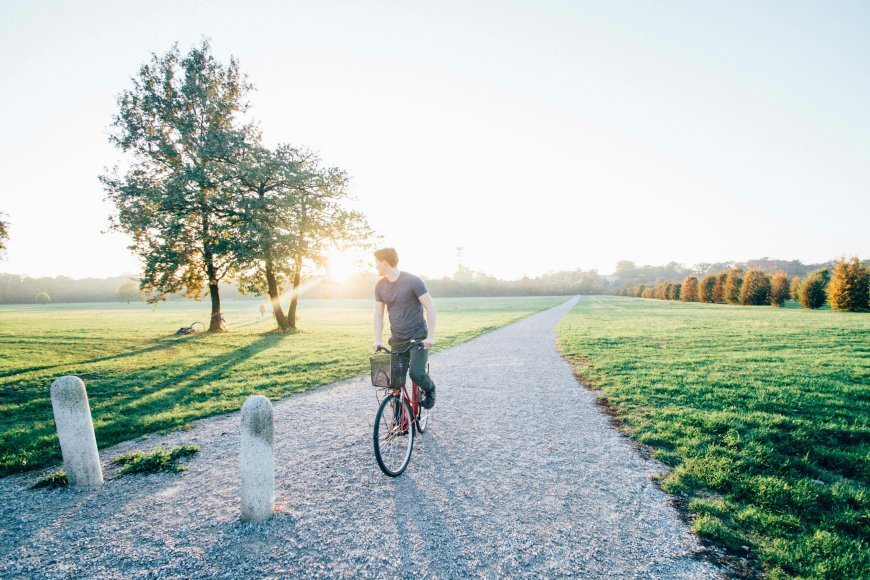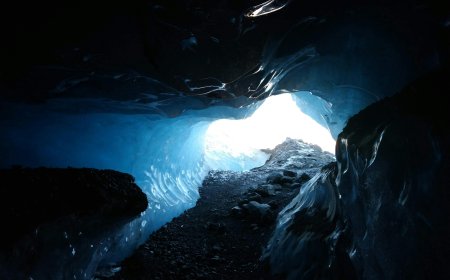The basic guidelines for safe cycling
To enjoy cycling safely in nature, remember that with enjoyment comes responsibility. Wear a helmet every time you ride to protect your head from serious injuries. Regularly inspect your bike to ensure its safety, checking for proper brakes and correctly inflated tires. It's also advisable to check for any damages to the bike before each trip, such as tire punctures or damaged wires. Additionally, don't forget to carry necessary emergency equipment like tire repair tools and a portable air pump. While riding, make sure to respect traffic laws, use turn signals clearly, and avoid excessive speed. In summary, enjoying nature requires a commitment to safety, so prepare well and enjoy your adventures safely.

To enjoy cycling safely in nature, remember that with enjoyment comes responsibility. Wear a helmet every time you ride to protect your head from serious injuries. Regularly inspect your bike to ensure its safety, checking for proper brakes and correctly inflated tires. It's also advisable to check for any damages to the bike before each trip, such as tire punctures or damaged wires. Additionally, don't forget to carry necessary emergency equipment like tire repair tools and a portable air pump. While riding, make sure to respect traffic laws, use turn signals clearly, and avoid excessive speed. In summary, enjoying nature requires a commitment to safety, so prepare well and enjoy your adventures safely.
The basic guidelines for safe cycling
Cycling in nature can be an exhilarating and enjoyable experience, but it also requires adhering to some basic guidelines to ensure personal safety and a positive overall experience.
1. Physical and Mental Preparedness:
Before embarking on a bike ride in nature, ensure you are physically and mentally prepared. Make sure you are in good health and have eaten a balanced meal before the trip. Be prepared to face the challenges and varying conditions you may encounter during the journey.
2. Physical Preparation:
Ensure that your bike is in good condition and suitable for the nature ride. Regularly inspect your bike to ensure its safety and that all parts are in good condition and properly adjusted.
3. Protective Gear:
Wear a helmet every time you ride your bike, whether on public roads or in nature. In addition to a helmet, other protective gear may include gloves and sunglasses to protect your hands and eyes from potential harm.
4. Food and Water Preparation:
Prepare an adequate amount of water and healthy food before the trip, especially if it's a long one. Hydration and energy levels should be high to enjoy the ride without any health issues.
5. Route and Environmental Knowledge:
Before starting the trip, study the chosen route and analyze the surrounding environment. Know the planned distance and expected weather conditions, and check for rest stops and facilities available along the way.
6. Balance and Control:
Maintain good balance while cycling in nature, especially when traversing rough terrain or trails. Use appropriate control techniques such as weight distribution and leaning to safely maneuver the bike.
7. Communication with Others:
Stay in touch with your fellow riders during the trip and exchange information about the situation and location. It is also advisable to inform a trusted person of your expected return time to ensure safety and communication in case of emergencies.
By following these basic guidelines, you can enjoy cycling in nature safely and confidently, and appreciate the beauty and thrilling experiences nature has to offer.
Tips for safe and enjoyable cycling in nature
1. Choose the Right Bike:
Before embarking on your nature adventure, make sure to select a bike suitable for the type of trip you're planning. A mountain bike might be suitable for rough terrain, while a hybrid or road bike may be suitable for smoother paths.
2. Bike Inspection:
Inspect your bike before every ride to ensure its safety. Make sure the tires are properly inflated and the brakes are working well. Check the steering and control system and ensure there are no damages or deformities in the tires.
3. Wear Protective Gear:
Don't forget to wear a helmet every time you ride your bike in nature. Use gloves to protect your hands and sunglasses to shield your eyes from the sun and debris.
4. Prepare Emergency Equipment:
Carry a small set of emergency equipment such as tire repair tools and a small air pump. You can also have a small bag containing emergency supplies like bandages and antiseptics.
5. Familiarize Yourself with the Trail:
Before setting out, study the chosen trail thoroughly. Know the difficult areas and rough terrains you may encounter on the way. You can also check maps and available information online to enhance your understanding of the area.
6. Respect Nature:
Cycling in nature means enjoying the beauty of the environment, so make sure not to leave any traces or debris behind. Respect wildlife and the surrounding environment, and avoid trespassing on protected areas.
7. Communication and Group Safety:
Go on trips with your companions or a group of fellow cyclists and hikers. Maintain continuous communication with each other and stick together to ensure safety and provide assistance in case of emergencies.
By following these tips, you can enjoy cycling trips in nature safely and with pleasure, while maintaining your safety and the safety of the surrounding environment.
Proper Preparation for Cycling Trips in Nature
Proper preparation for cycling trips in nature is essential to ensure a fun and safe outdoor experience.
1. Route and Destination Selection:
Before starting your journey, identify the trail you want to explore and the destination you aim to reach. Look for nature bike trails available in the area you intend to visit and choose the most suitable one for your skill level and the enjoyment you seek.
2. Bike Inspection:
Ensure your bike is in excellent condition before the trip. Check the tires for any punctures or damage. Inspect the brake system and gears to ensure their safety and proper function.
3. Bike Adjustment:
Adjust the bike according to the requirements of the trip. Set the handlebar and seat height to ensure body comfort and enhance performance while riding. Make sure the handlebar is securely fastened, and the wheels are present and sturdy.
4. Proper Clothing Selection:
Wear appropriate clothing for the weather conditions and the length of the trip. Choose clothes that provide comfort, ventilation, and allow freedom of movement. It is also advisable to wear long clothes to protect the skin from scratches and burns in case of falls.
5. Packing Necessary Equipment:
Load your backpack or rear basket with the necessary equipment for the trip. Carry a water bottle and snacks such as dried fruits and nuts to maintain energy during the journey. It is also recommended to carry first aid supplies and basic bike repair tools.
6. Communication with Others:
Before setting off, inform a trusted person of your trip route and the expected time of return. You can also share your current location with a family member or friend using location tracking apps for safety.
7. Balancing Fun and Safety:
Always remember that the primary goal is to enjoy the trip, so choose trails and challenges that suit your skills and physical abilities. Do not exceed your limits and take unnecessary risks that may affect your safety.
By following these steps and proper preparations, you can enjoy cycling trips in nature safely and comfortably, and appreciate the beauty and tranquility of nature in an enjoyable and relaxing manner.
How to Protect Yourself While Cycling in Nature
Protecting yourself while cycling in nature is of utmost importance to ensure your safety and enjoy the experience safely and pleasantly.
1. Wear a Helmet:
A helmet is one of the most important protective measures while cycling in nature. Choose a helmet that fits your head size and provides effective protection for your skull and brain in case of an accident. Ensure that the helmet is approved by safety authorities.
2. Use Personal Protective Equipment:
In addition to a helmet, it's recommended to wear gloves to protect your hands from injuries and scratches in case of a fall, and wear sunglasses to protect your eyes from the sun, dust, and debris during the trip.
3. Pay Attention to Clothing:
Wear appropriate and comfortable clothing while biking in nature. Choose clothes that provide protection from weather conditions such as heat, cold, and moisture, and allow ventilation to provide comfort during the trip.
4. Learn Safe Riding Techniques:
Learn safe riding techniques in nature, such as maintaining balance on rough terrains, avoiding excessive speed on steep slopes, and using brakes carefully to prevent slips and collisions.
5. Prepare for Emergencies:
Carry a small emergency kit with you, such as tire repair tools and a small air pump. It's also advisable to carry a charged mobile phone and a list of emergency numbers in case assistance is needed.
6. Communication and Environmental Awareness:
Communicate with other riders during the trip and exchange information about the route and selected trails. You should also be aware of the surrounding environment, weather conditions, and terrain nature to be prepared to deal with any potential challenges.
7. Maintain Focus and Attention:
Maintain focus and attention while riding and avoid distractions such as mobile phones or listening to loud music. Full focus on the road and the surrounding environment helps to avoid accidents and injuries.
By following these tips and guidelines, you can effectively protect yourself while cycling in nature and enjoy a safe and enjoyable outdoor experience.
Basic Inspection Essentials
Inspecting the bike before every trip in nature is essential to ensure your safety, the safety of others, and to ensure that the bike is in good condition for riding.
1. Tires:
Inspect the tires to ensure there are no punctures or tears. Use the appropriate air pressure and make sure the tires are properly inflated and able to withstand the necessary pressure for the nature trip.
2. Brakes:
Make sure the brake system is functioning properly and that the brakes are well adjusted. Check both the front and rear brakes and test them to ensure their ability to stop effectively in case of emergencies.
3. Gears:
Inspect the gear system and ensure there are no issues in shifting gears. Check the bike chains for safety and ensure there is no corrosion or damage to them.
4. Steering System:
Inspect the steering system and ensure there are no deformities or damage in the handlebar or steering wheel. Make sure the handlebar is securely fastened and that there is no unusual wobbling during riding.
5. Lights and Signals:
Ensure the safety of the front and rear lights and turn signals. Check the battery if the bike operates on a specific lighting system and ensure its strength and proper functioning.
6. Vibration Control:
Test vibration control and ensure there is no unusual vibration during riding. Inspect the seats and handlebars to ensure their safety and stability during the trip.
7. Additional Accessories:
Ensure the safety of any additional accessories such as bottle holders or rear bags. Make sure they are securely fastened and do not affect the stability of the bike during riding.
By completing these basic inspection steps, you can be confident in the safety of your bike and ready to enjoy your nature trip without any worries about potential technical issues.
Necessary Equipment and Precautions for Cycling in Nature
Cycling in nature requires thorough preparation and readiness to ensure safety and enjoy the trip comfortably.
1. Helmet:
A helmet is essential for safety while cycling in nature. Choose a helmet that fits your head size and meets safety standards. Ensure it provides effective protection for your skull and brain in case of an accident.
2. Sunglasses:
Wear sunglasses to protect your eyes from UV rays, debris, and dust during the nature ride. Make sure the sunglasses provide clear vision without obstructing your view.
3. Gloves:
Use gloves to protect your hands from injuries in case of falls or contact with brakes or sharp objects on the road. Choose comfortable and durable gloves that provide a good grip on the bike.
4. Appropriate Clothing:
Wear comfortable and weather-appropriate clothing for the cycling conditions in nature. Choose clothes made of breathable and moisture-wicking materials to stay dry and comfortable during the trip.
5. Tires and Brakes:
Before each trip, check the tires for any punctures or damage. Also, ensure the brakes are working well and capable of stopping the bike quickly and safely when needed.
6. Additional Equipment:
Carry a set of additional equipment such as basic tire repair tools and a portable air pump. It's also advisable to carry a small kit of essential medical tools to address minor injuries.
7. Communication and Route Knowledge:
Make sure you are familiar with the chosen route and the surrounding natural conditions. Update yourself with maps and available information about the trails and different areas you will pass through during the trip.
8. Physical Preparation:
Prepare yourself physically before the trip by engaging in sports, strengthening muscles, and improving physical fitness. This will help you endure and deal with rough terrain and challenges you may encounter during the trip.
By preparing well and using the necessary equipment, you can safely and enjoyably enjoy cycling trips in nature while maintaining your safety and comfort throughout the journey.
Enjoy nature safely
Enjoying nature safely while biking requires taking several precautions and respecting some guidelines to ensure a safe and enjoyable experience.
1. Preparing in Advance:
Before embarking on a bike trip in nature, prepare in advance by checking the weather conditions, the chosen route, and the geographical conditions of the area. It's also advisable to download electronic maps and GPS directions if available.
2. Necessary Equipment:
Make sure to carry all necessary equipment such as a helmet, sunglasses, biking gloves, tire repair tools, drinking water, and snacks. Additionally, carrying a charged mobile phone and paper maps as a backup is recommended.
3. Attention and Focus:
Stay focused and attentive while biking in nature, avoiding distractions such as mobile phones. Follow traffic laws, avoid speeding, and be cautious when crossing roads and intersections.
4. Respect for the Environment:
Respect the surrounding environment and leave no traces behind. Camp and hike in designated areas, avoid littering, and do not pollute freshwater sources. Be aware of wildlife and avoid approaching wild animals.
5. Communication and Reporting:
In case of any problems or emergencies during the trip, communicate with relevant authorities such as rescue teams or local police. It's also recommended to share your trip plan with a friend or family member, informing them of the chosen route and expected return time.
6. Enjoying Nature Safely:
Always remember that the main goal of biking in nature is to enjoy the scenery and nature's beauty. Therefore, enjoy the trip safely and responsibly without causing any trouble for yourself or others.
By following these measures and guidelines, you can enjoy biking in nature safely and comfortably, appreciating the beauty of nature and its experiences in a unique and relaxing way.
Summary
Basic guidelines for safe cycling in nature include several important points. Riders should wear helmets and appropriate clothing and use personal protective equipment. Additionally, the bike should be checked before the trip, and necessary emergency equipment should be provided. Maintaining focus and balance while riding, respecting traffic laws and the surrounding environment are essential. By following these guidelines, individuals can enjoy cycling in nature safely.
Sources
1. World Health Organization (WHO) Website
The World Health Organization website provides a range of resources and information on road safety and cycling, including guidelines for safe cycling.
2. League of American Bicyclists Website
This organization offers resources and guidance for cyclists, including educational materials and tips for safe cycling.
3. Cycling UK Website
This website provides tips and guidance for cyclists in the United Kingdom and around the world, including safety and traffic regulations.
What's Your Reaction?











































































































